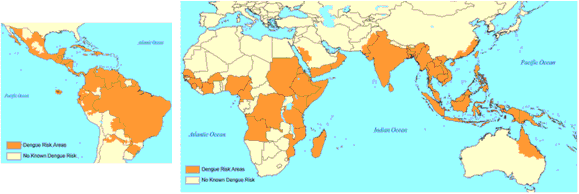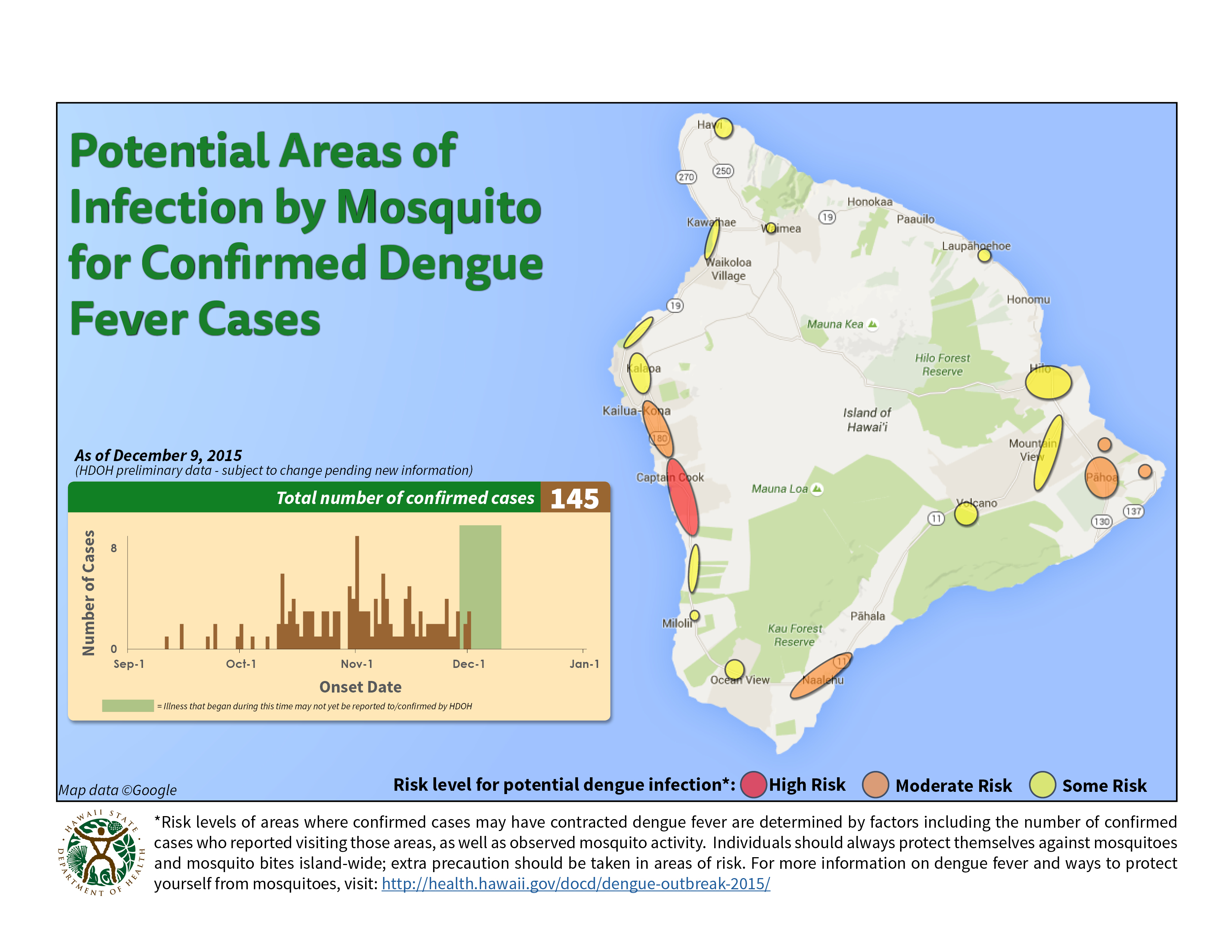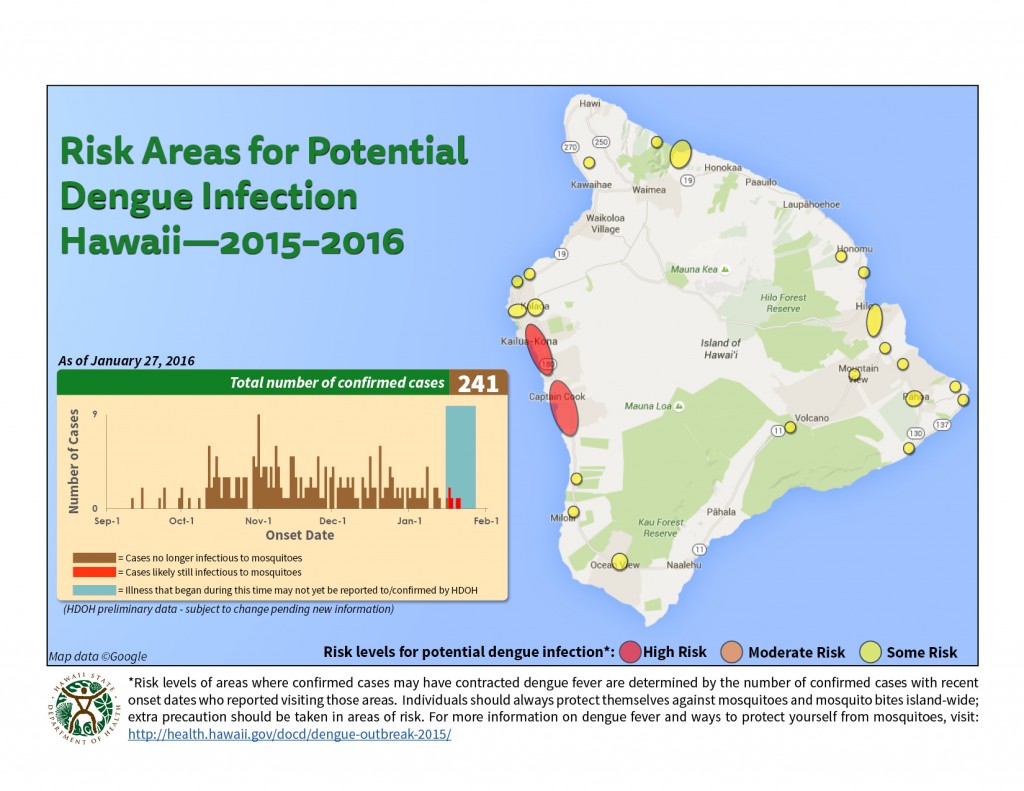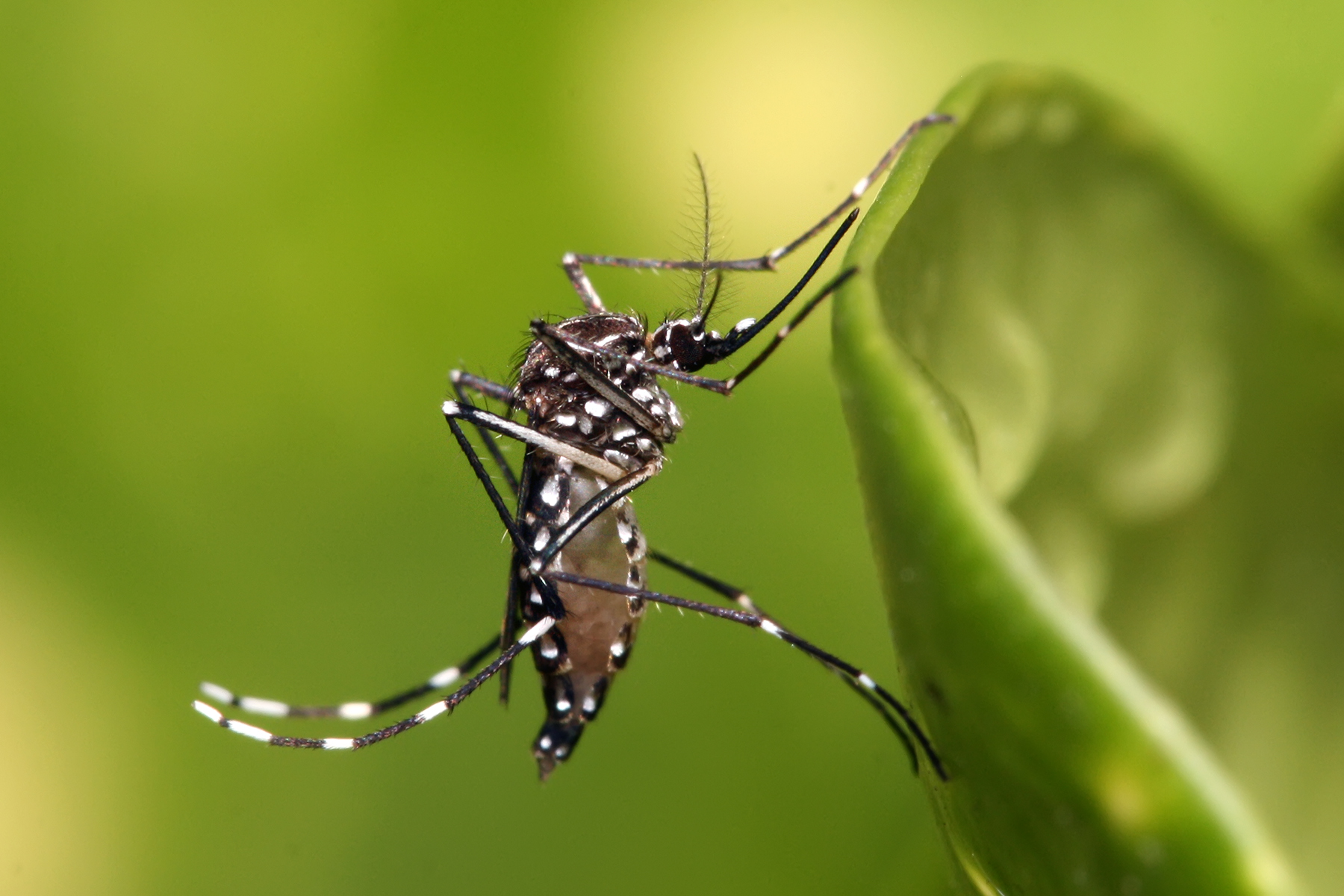Archive for the ‘Dengue’ Category
Hawaii mobilizes to prevent mosquito borne illnesses
Tuesday, February 16th, 2016Governor’s Office News Release: State mobilizes to prevent mosquito borne illnesses
HONOLULU – Gov. David Ige signed an emergency proclamation Friday, as a preventive measure against mosquito borne illnesses that include dengue fever and Zika. This follows the recent decision by the Centers for Disease Control and Prevention (CDC) to open its emergency operations center at Level 1 to prepare for and mitigate the Zika risk.
“There have been no locally acquired Zika cases in the U.S. or Hawai‘i, and we’d like to keep it that way. This is about getting in front of the situation across the state. I will be coordinating planning efforts with the Hawai‘i Emergency Management Agency, all county mayors and Civil Defense coordinators,” said Gov. Ige.
On Hawai‘i Island, dengue fever cases continue to be fewer and farther between. However, the battle is not over and state continues to focus resources to break the cycle of dengue fever infection and transmission.
The emergency proclamation will give the state access to the Major Disaster Fund, the option of waiving certain laws and regulations to expedite the outbreak response if and when needed, as well as pave the way for federal assistance should the state exhaust its resources.
The state previously released the State Health Department from a 5 percent budget restriction ($250,000) to fund costs incurred while responding to the onset of the dengue outbreak.
The state is also releasing the Health Department from another 5 percent restriction ($250,000) to fund eight vector control positions, one entomologist and one communications position.
The emergency proclamation can be found here.
###
Media Contacts:
Jodi Leong
Deputy Communications Director/Press Secretary
Office of the Governor
Office: 808-586-0043
Mobile: 808-798-3929
jodi.c.leong@hawaii.gov
Cindy McMillan
Communications Director
Office of the Governor
Office: 808-586-0012
Mobile: 808-265-7974
cindy.mcmillan@hawaii.gov
** Dengue’s global burden: The dengue incidence has increased six-fold from 1990 to 2013
Monday, February 15th, 2016“…..We estimated an average of 9221 dengue deaths per year between 1990 and 2013, increasing from a low of 8277 (95% uncertainty estimate 5353–10 649) in 1992, to a peak of 11 302 (6790–13 722) in 2010. This yielded a total of 576 900 (330 000–701 200) years of life lost to premature mortality attributable to dengue in 2013. The incidence of dengue increased greatly between 1990 and 2013, with the number of cases more than doubling every decade, from 8·3 million (3·3 million–17·2 million) apparent cases in 1990, to 58·4 million (23·6 million–121·9 million) apparent cases in 2013. When accounting for disability from moderate and severe acute dengue, and post-dengue chronic fatigue, 566 000 (186 000–1 415 000) years lived with disability were attributable to dengue in 2013. Considering fatal and non-fatal outcomes together, dengue was responsible for 1·14 million (0·73 million–1·98 million) disability-adjusted life-years in 2013…..the true symptomatic incidence of dengue probably falls within the commonly cited range of 50 million to 100 million cases per year. ”
** Many of the fatal dengue cases in 2013 occurred in Southeast Asia (5,376 deaths) and South Asia (2,132 deaths).
** Death rates in tropical and central Latin America and the Caribbean increased from 1990 to 2013
** Most dengue-related deaths (7,018) in 2013 occurred in individuals belonging to the lower middle-class income group.
** The researchers acknowledge that their models resulted in estimates of mortality incidence that are significantly lower than the World Health Organization’s estimate of 10,000 to 20,000 deaths caused by dengue each year.

Hawaii’s Big Island declares emergency over dengue fever infections with 250 cases confirmed over the past 4 months.
Tuesday, February 9th, 2016Hawaii reports 244 dengue cases
Wednesday, February 3rd, 2016Aedes aegypti and Aedes albopictus mosquitoes can transmit the viruses that cause dengue fever.
The Hawaii Department of Health (HDOH) is investigating a cluster of locally-acquired cases of dengue fever on Hawaii Island (the Big Island). Dengue is not endemic to Hawaii. However, it is intermittently imported from endemic areas by infected travelers. This is the first cluster of locally-acquired dengue fever since the 2011 outbreak on Oahu. The Big Island and the rest of Hawaii remain safe destinations for visitors and residents.
As of February 2, 2016*:
Since the last update, HDOH has identified 2 new cases of dengue fever. Currently, as many as 3 of the confirmed cases to date are potentially infectious to mosquitoes. All others are no longer infectious.
| Potentially infectious individuals |
3 | Illness onset 1/23/16 to 1/26/16 |
| Cases no longer infectious |
243 | Illness onset 9/11/15 to 1/21/16 |
| Past and present confirmed cases (Cumulative TOTAL) |
246 | |
Of the confirmed cases, 222 are Hawaii Island residents and 24 are visitors.
201 cases have been adults; 45 have been children (<18 years of age). Onset of illness has ranged between 9/11/15 – 1/25/16.
As of today, a total of 1071 reported potential cases have been excluded based on test results and/or not meeting case criteria.
For Hawaii Island Dengue Fever Unified Command Updates, click HERE. (Updated January 20, 2016)
HDOH continues to routinely monitor for cases of imported dengue infection on ALL islands and will continue to have Vector Control perform mosquito site assessments and abatement as needed. Since the beginning of our current investigation on Hawaii island, thirteen imported dengue fever cases have been confirmed (seven on Oahu, three on Maui, two on Hawaii, 1 visitor), and one imported chikungunya case (on Hawaii) has been confirmed. These cases are not associated with the Hawaii island investigation.
2 types of non-native mosquitoes (Aedes Aegypti and Aedes Albopictus) that can transmit potentially fatal diseases have spread throughout California.
Saturday, January 2nd, 2016
** “….First found in California in 2013, Aedes Aegypti and Aedes Albopictus have roughly tripled in number around the state during the past several seasons. They’re now found in 82 cities, including Escondido, Los Angeles, Fresno and parts of the Bay Area. At the beginning of this year, the count was 28 cities….”
** “…So far, California has seen no locally acquired cases of disease spread by these mosquitoes, which include dengue fever, yellow fever and Chikungunya……”
Dengue Fever in Hawaii: 153 confirmed cases
Wednesday, December 16th, 2015As of December 15, 2015*:
| Hawaii Island residents | 136 |
| Visitors | 17 |
| Confirmed cases, TOTAL | 153 |
Of the confirmed cases, 136 are Hawaii Island residents and 17 are visitors.
120 cases have been adults; 33 have been children (<18 years of age). Onset of illness has ranged between 9/11/15 – 12/8/15.

Lyon, France – December 9, 2015 – Sanofi Pasteur, the vaccines division of Sanofi, announced today that the Mexican authorities have granted marketing authorization to Dengvaxia®, making it the first vaccine to be licensed in the world for the prevention of dengue.
Friday, December 11th, 2015Lyon, France – December 9, 2015 – “Sanofi Pasteur, the vaccines division of Sanofi, announced today that the Mexican authorities have granted marketing authorization to Dengvaxia®, making it the first vaccine to be licensed in the world for the prevention of dengue.
The Federal Commission for the Protection against Sanitary Risks (COFEPRIS) has approved Dengvaxia®, tetravalent dengue vaccine, for the prevention of disease caused by all four dengue virus serotypes in preadolescents, adolescents and adults, 9 to 45 years of age living in endemic areas…..
The COFEPRIS approval of Dengvaxia® is based on results from an extensive clinical development program involving over 40,000 people of different ages, geographic and epidemiological settings, and ethnic and socio-economic backgrounds living in 15 countries. Dengue-endemic regions of Mexico participated in all three phases of the clinical development program for the vaccine…..Disease impact modelling results indicate if you vaccinate 20% of the population in the 10 endemic countries that participated in the Phase III efficacy studies for Dengvaxia, in the ages 9 and above indication, you could potentially reduce your dengue burden by 50% in five years. Such a significant disease reduction in this large at-risk population would result in a smaller pool of infected individuals in a given country and, therefore, fewer mosquitoes capable of transmitting the disease, potentially leading to an overall lowering of transmission risk for all…….”
139 cases of Dengue Fever in Hawaii
Tuesday, December 8th, 2015As of December 7, 2015*:
| Hawaii Island residents | 122 |
| Visitors | 17 |
| Confirmed cases, TOTAL | 139 |
Of the confirmed cases, 122 are Hawaii Island residents and 17 are visitors.
108 cases have been adults; 31 have been children (<18 years of age). Onset of illness has ranged between 9/11/15 – 11/30/15.

117 confirmed dengue cases in Hawaii
Wednesday, December 2nd, 2015The Hawaii Department of Health (HDOH) is investigating a cluster of locally-acquired cases of dengue fever on Hawaii Island. Dengue is not endemic to Hawaii. However, it is intermittently imported from endemic areas by infected travelers. This is the first cluster of locally-acquired dengue fever since the 2011 outbreak on Oahu.
As of December 1, 2015*:
| Hawaii Island residents | 103 |
| Visitors | 14 |
| Confirmed cases, TOTAL | 117 |
Of the confirmed cases, 103 are Hawaii Island residents and 14 are visitors.
88 cases have been adults; twenty-nine have been children (<18 years of age). Onset of illness has ranged between 9/11/15 – 11/20/15.

Dengue fever in Hawaii: Confirmed cases, 80 are Hawaii residents and 13 are visitors.
Wednesday, November 25th, 2015 Aedes aegyptii
Aedes aegyptii
 Aedes albopictus
Aedes albopictus
The Hawaii Department of Health (HDOH) is investigating a cluster of locally-acquired cases of dengue fever on Hawaii Island. Dengue is not endemic to Hawaii. However, it is intermittently imported from endemic areas by infected travelers. This is the first cluster of locally-acquired dengue fever since the 2011 outbreak on Oahu.
As of November 24, 2015*:
| Hawaii Island residents | 80 |
| Visitors | 13 |
| Confirmed cases, TOTAL | 93 |
Of the confirmed cases, 80 are Hawaii residents and 13 are visitors.
70 cases have been adults; 23 have been children (<18 years of age). Onset of illness has ranged between 9/11/15 – 11/17/15.





